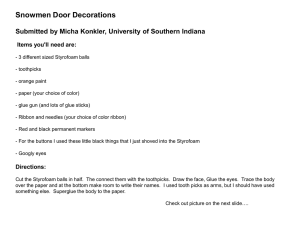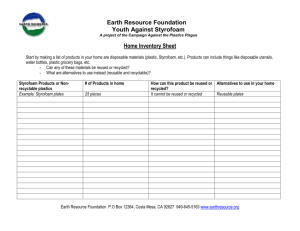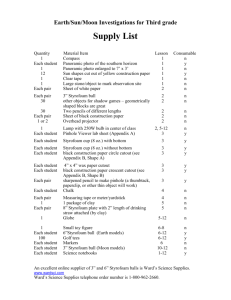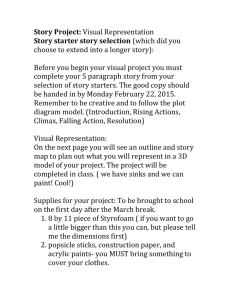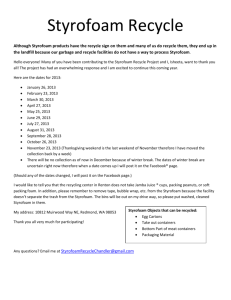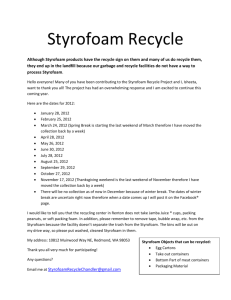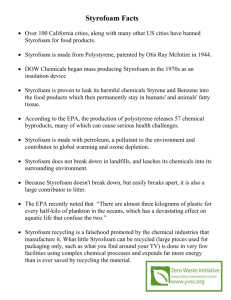Maribel Villarreal Individual Work Project Overview In 2005
advertisement
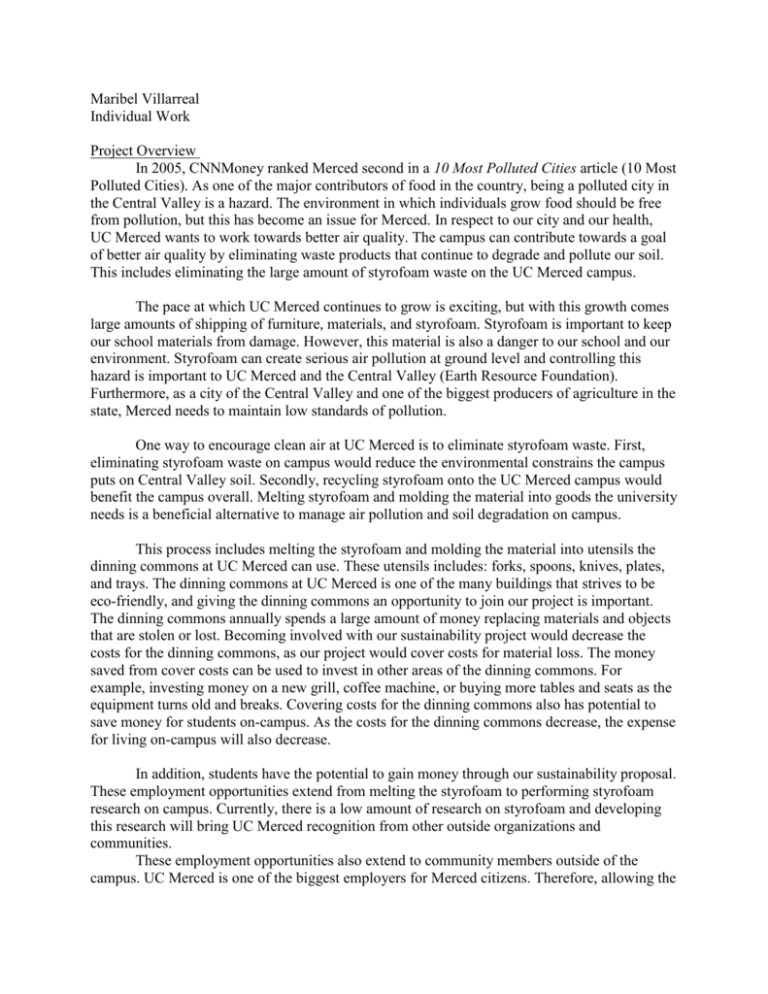
Maribel Villarreal Individual Work Project Overview In 2005, CNNMoney ranked Merced second in a 10 Most Polluted Cities article (10 Most Polluted Cities). As one of the major contributors of food in the country, being a polluted city in the Central Valley is a hazard. The environment in which individuals grow food should be free from pollution, but this has become an issue for Merced. In respect to our city and our health, UC Merced wants to work towards better air quality. The campus can contribute towards a goal of better air quality by eliminating waste products that continue to degrade and pollute our soil. This includes eliminating the large amount of styrofoam waste on the UC Merced campus. The pace at which UC Merced continues to grow is exciting, but with this growth comes large amounts of shipping of furniture, materials, and styrofoam. Styrofoam is important to keep our school materials from damage. However, this material is also a danger to our school and our environment. Styrofoam can create serious air pollution at ground level and controlling this hazard is important to UC Merced and the Central Valley (Earth Resource Foundation). Furthermore, as a city of the Central Valley and one of the biggest producers of agriculture in the state, Merced needs to maintain low standards of pollution. One way to encourage clean air at UC Merced is to eliminate styrofoam waste. First, eliminating styrofoam waste on campus would reduce the environmental constrains the campus puts on Central Valley soil. Secondly, recycling styrofoam onto the UC Merced campus would benefit the campus overall. Melting styrofoam and molding the material into goods the university needs is a beneficial alternative to manage air pollution and soil degradation on campus. This process includes melting the styrofoam and molding the material into utensils the dinning commons at UC Merced can use. These utensils includes: forks, spoons, knives, plates, and trays. The dinning commons at UC Merced is one of the many buildings that strives to be eco-friendly, and giving the dinning commons an opportunity to join our project is important. The dinning commons annually spends a large amount of money replacing materials and objects that are stolen or lost. Becoming involved with our sustainability project would decrease the costs for the dinning commons, as our project would cover costs for material loss. The money saved from cover costs can be used to invest in other areas of the dinning commons. For example, investing money on a new grill, coffee machine, or buying more tables and seats as the equipment turns old and breaks. Covering costs for the dinning commons also has potential to save money for students on-campus. As the costs for the dinning commons decrease, the expense for living on-campus will also decrease. In addition, students have the potential to gain money through our sustainability proposal. These employment opportunities extend from melting the styrofoam to performing styrofoam research on campus. Currently, there is a low amount of research on styrofoam and developing this research will bring UC Merced recognition from other outside organizations and communities. These employment opportunities also extend to community members outside of the campus. UC Merced is one of the biggest employers for Merced citizens. Therefore, allowing the community to become involved with this sustainability project, while at the same time providing jobs will strengthen the ties between UC Merced and the Merced community. Projected Benefits Being a part of the Central Valley, keeping Merced clean is pivotal to the nation’s agriculture. UC Merced can be involved in this cause by encouraging the Merced community to recycle styrofoam. Once the campus demonstrates the multiple benefits recycling styrofoam offers, the Merced community will want to join our project to eliminate styrofoam waste. This includes extending our project to Merced schools, business’, and citizens who wish to join the cause. Short-term benefits the campus will receive are lower costs at the dinning commons. As our project continues to provide utensils and supplies to the building, a large amount of their profits will not be spent on lost or broken inventory. This leaves an opportunity for the dinning commons to invest in new equipment that needs replacing or repairing. Furthermore, the surplus of money available at the dinning commons has potential to decrease costs for students oncampus. The dinning commons charges students for utensils and refurbishment costs. Therefore, decreasing costs for the dinning commons will also decrease extra costs students bear for living on-campus. Also, the process of melting styrofoam needs workers, therefore creating employment opportunities on-campus. The citizens of Merced can work on the process of melting and molding the Styrofoam into utensils. This serves as a way to bring the community of Merced on board with our project, while benefiting the Merced economy. In addition, students can work in the process of melting the styrofoam or find employment opportunities for performing research in the area of styrofoam. Currently, there are low levels of styrofoam research being done. However, Merced has potential to be one of the leaders in styrofoam research. Some research questions include the effect of styrofoam on soil degradation or the effects of styrofoam on the human body. Styrofoam research can be performed by students of all majors. This includes, biology, chemistry, physics, and engineering. In fact, engineering students can research or invent new ways in which styrofoam can be melted and molded more effectively. Overall, through research the UC Merced student body can help support our claim to eliminate styrofoam waste, and encourage the UC Merced community to join our project. Furthermore, recycling styrofoam lowers the amount of waste that is stored in landfills. More then half of America’s solid waste gets dumped into landfills. However, many new landfills can create harmful landfill gas emissions, and convert the gas into energy (Landfills, Municipal Solid Waste). By eliminating styrofoam waste, the campus also decreases the amount of waste that goes into landfills. "Earth Resource Foundation." Earth Resource Foundation. N.p., n.d. Web. 03 May 2014. "10 Most Polluted Cities." CNNMoney. Cable News Network, n.d. Web. 05 May 2014. "Landfills, Municipal Solid Waste." EPA. Environmental Protection Agency, n.d. Web. 10 May 2014.
